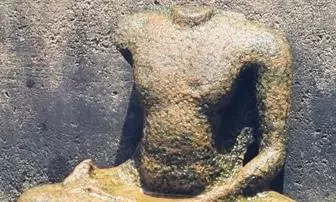Rare Buddha Statue Found in Mangaluru
The discoveries were made during a recent archaeological exploration near the sacred pond at Sri Kadri Manjunatha Temple

Mangaluru: In a significant archaeological find at Kadri in Mangaluru, a rare sculpture of the Buddha in a meditative posture has been found alongside a group of ancient rock-cut caves believed to date back to the 4th to 6th centuries CE.
The discoveries were made during a recent archaeological exploration near the sacred pond at Sri Kadri Manjunatha Temple. Sharing details Prof. T. Murugeshi, retired associate professor of Ancient History and Archaeology at Mulki Sundar Ram Shetty (MSRS) College, Shirva told Deccan Chronicle that the Buddha sculpture which is missing its head, was found submerged in the pond near the temple and retrieved with the temple administration’s permission for further study.
"It is well known that Kadri was once a centre of Buddhist worship. However, most of the sculptures previously found in the area belong to the Vajrayana sect. This newly discovered sculpture, in contrast, dates back to the 4th to 6th century CE and is associated with the Mahayana sect of Buddhism. It depicts a meditating figure seated in Padmasana on a lotus pedestal. The right arm of the statue is broken, while the left hand rests between crossed legs. Traces of a draped upper garment (uttariya) are faintly visible across the left shoulder and chest. The head is missing, and due to the stylistic features and iconographic parallels with similar sculptures found in Goa’s Mushirawado region, it has been identified as a Buddha statue,” Murugeshi said.
The sandstone sculpture measures approximately 68 cm in height and 48 cm in width. The presence of a fixing peg beneath the pedestal suggests it may once have been the main deity of an ancient shrine in the region.
“People had seen this statue in the pond but nobody had studied it. During our exploration we studied the statue and also three ancient rock-cut caves in the hillside above the temple ponds,” he added.
“Carved into laterite rock, these caves show clear architectural planning. The entrance to one of the caves resembles the megalithic dolmen-type burial entrances, while the other two, located on an elevated platform, have plain square doorways. The caves are plain inside, with small niches that may have held oil lamps, suggesting they were used as monks' dwellings or meditation spaces,” he added.
Prof. Murugeshi noted that the style and simplicity of the caves’ architecture are consistent with early historic Buddhist rock-cut architecture of the 4th–6th centuries CE. These findings, he said, push back the antiquity of Kadri and support the view that it was once a significant Mahayana Buddhist centre, later transitioning into a Vajrayana and eventually a Nath tradition stronghold in South India.
Prof. Murugeshi also thanked the support and cooperation of temple administrator Arun Kumar and expressed gratitude to research scholars and students who assisted in the exploration.

